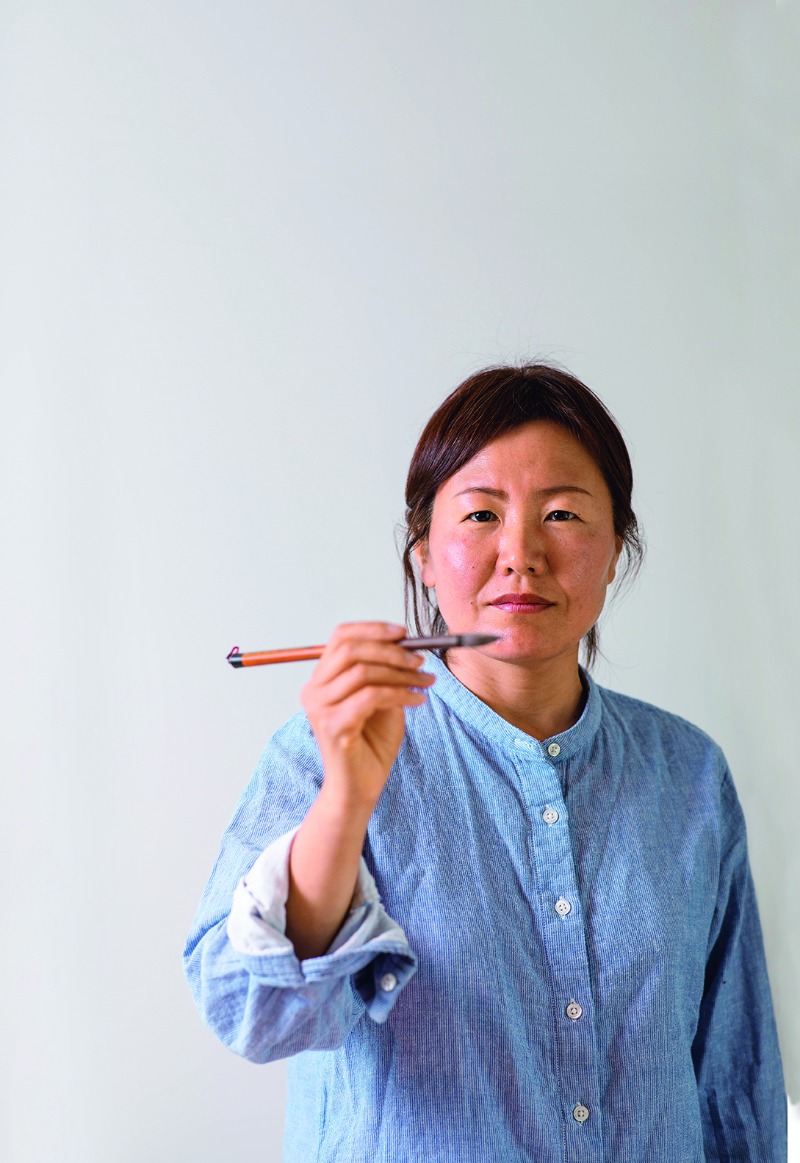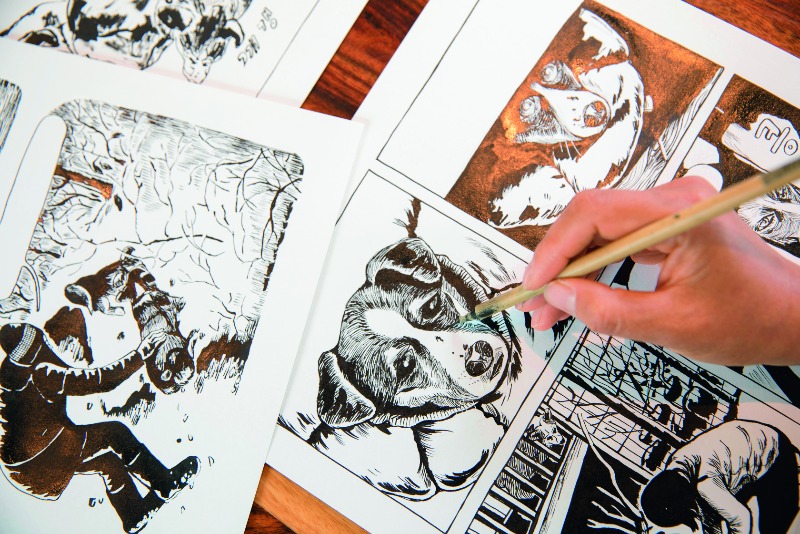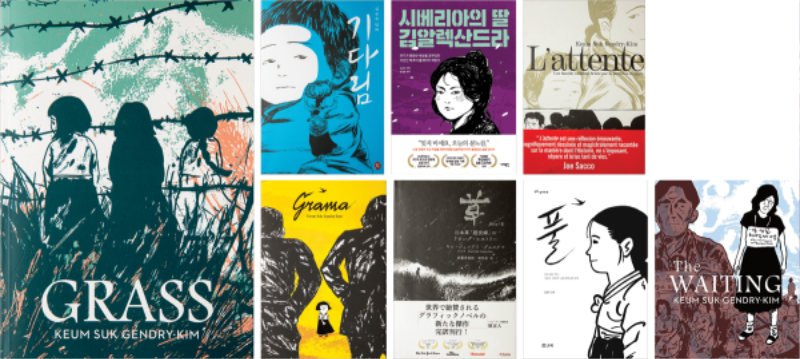Translations of Keum Suk Gendry-Kim’s graphic novels attract global recognition – and none more so than “Grass,” which delves into the pain of the “comfort women” forced into wartime sexual slavery by the Imperial Japanese military.

A scene from “Grass,” a graphic novel by Keum Suk Gendry-Kim, portraying a “comfort woman,” a victim of Imperial Japan’s wartime sexual slavery.
Gendry-Kim explores major historical events in her graphic novels while also centering the stories of those on the margins of society.
Keum Suk Gendry-Kim dives deeply into human suffering. Her subjects are Koreans and her settings are events in Korean history. Nevertheless, the anguish embossed in her works elicits a cross-cultural understanding and praise. Her 2017 graphic novel, “Grass,” featuring one of the “comfort women” victimized by the Japanese military before and during World War II, is the apex of the recognition she has earned so far.
The English edition of “Grass” was released in 2019 by Canadian publisher Drawn & Quarterly and quickly garnered plaudits. The New York Times named it one of the best comics on its list of the best books of 2019, and The Guardian similarly called it one of the year’s best graphic novels. In 2020, “Grass” was showered with 10 awards, including the Krause Essay Prize and the Cartoonist Studio Prize, as well as the Harvey Award for Best International Book at the New York Comic Con.
“Grass” was recently made available in Portuguese and Arabic. Other books by Gendry-Kim include “Jiseul” (2014), which depicts the tragedy of the Jeju uprising in 1948 against the division of Korea, and “Alexandra Kim, a Woman of Siberia” (2020), which traces the life and times of Korea’s first-ever Bolshevik. Gendry-Kim’s latest, “The Waiting,”about family separation, is already out in French and in the process of publication in English, Portuguese, Arabic and Italian. At a café on Ganghwa Island, where she now lives, Gendry-Kim shared her thoughts.
How did you end up as a graphic novelist?
Well, after I majored in Western-style painting in Korea, I went to France where I studied installation art at the École Supérieure des Arts Décoratifs de Strasbourg. To make ends meet, I took part-time jobs translating the work of Korean cartoonists into French, eventually making a bit of a name for myself in that arena. Actually, I translated over 100 Korean comic books and helped them find a French audience.
Then one day, a Korean newspaper based in France asked whether I might be interested in trying my hand at drawing comics myself. Meanwhile, translating all those comics had opened my eyes to the possibilities of the art form. I was captivated by the fact that these authors were able to express themselves so freely and fully with justpaper and pencil. So I began drawing, one at a time, and before long I had quite a few. From the very beginning, I spent a lot of time and effort considering the best way to capture the flow of conversation, whether in speech bubbles or otherwise.
What works influenced you?
In terms of story, I’ve been influenced by many Korean authors. Lee Hee-jae and Oh Se-young, for example, are two that come to mind; they did a particularly fine job of representing the father figures of our generation in comic book form. In terms of the art, as most of my own fine art work has been abstract rather than representational, or even installation or sculpture, I always thought of myself as not being very skilled at drawing. That said, among those artists who have certainly influenced my graphic style are Edmond Baudoin and Jose Muñoz, who published a graphic novel version of Camus’s “The Stranger” – especially in terms of emphasizing the weight of the black brush strokes. The works of David B. and Jacques Tardi, too, have also helped shape mine in many ways.
Which early work best introduces you?
I tend to weave autobiography together with various things that I’ve felt in the course of daily life and the individual stories of people I’ve met. I try to center the most earnest Translations of Keum Suk Gendry-Kim’s graphic novels attract global recognition – and none more so than “Grass,” which delves into the pain of the “comfort women” forced into wartime sexual slavery by the Imperial Japanese military. Kim Tae-hun Reporter, Weekly Kyunghyang Ha Ji-kwon Photographer42 KOREANA SUMMER 2021 stories that emerge as I forge connections between things I’ve experienced firsthand and various historical events and societal issues. Of these, “Le chant de mon père” (The Songof My Father, 2013) is a story set in 1970s-80s Korea, when economic reasons force an ordinary farming family in the countryside to make the move to Seoul to try to build a new life. That was me using a difficult period in my own family history as a lens to reflect what was a fairly universal Korean experience at that time. I also wanted to capture some of my childhood memories. My father sings pansori, so when I was young, whenever someone in the village passed away, he would perform the funeral song. After we moved to Seoul, though, there was no way of knowing whether anyone in the neighborhood had passed, and there was no occasion anymore for my father to sing
Your father and now your mother are your subjects.
“The Waiting” (2020) is a work entirely about my mother. Twenty years ago when I was studying in Paris, my mother came to visit me, and it was then that she shared something with me for the first time: that her sister, my eldest maternal aunt, was in North Korea. A long time ago, their family took a big trip from their home in Goheung, South Jeolla Province, all the way to Manchuria, stopping in Pyongyang along the way. Something happened while they were there and my mother returned to the South but my eldest aunt stayed there. Before my mother told me about this, I had no idea that it was part of our family story.
My mother was very disappointed when she wasn’t selected to be part of the North-South family reunion efforts run by the Ministry of Unification. This made it feel evenmore vital for someone to tell her story, and I made up my mind that it would be me a kind of gift, an offering dedicated to my mother. Family separation, though, is an issue that goes far beyond the story of my own family; it’s a universal problem faced by all of humanity, happening even now in wartorn areas all over the world. Ultimately, I wanted to cover the way war results in the victimization of the vulnerable, in their displacement and scattering.
“Grass” might also be called a tragedy of humanity.
If I try and remember when I first started thinking about writing “Grass,” I think the actual inception point was in the early 1990s, when I saw a documentary about the plight of the comfort women. Then later, in France, I actually had a gig working as an interpreter for an event about comfort women, and as I did my research for that, I ended up learning more details. This is how I eventually ended up submitting the short story “Secret” to the 2014 Festival International de la Bande Dessinéed’Angoulême. I wanted to give voice to the lives and pain of the comfort women victims from the perspective of a fellow woman.
Because “Secret” was a short piece, though, I was unable to go as deep as I would have liked for such a heavy topic. So I kept at it for three more years, in the end, anddid a whole lot more agonizing, finally turning it into a full length novel. I approached the issue of the comfort women as a matter of violence against the vulnerable, of imperialism and class stratification. Meeting and interviewing Grandma Lee Ok-seon, who appears in the novel, I was especially saddened by how she had been silenced. Grandma Lee was the victim of a cruel and wretched war, unable to speak up. But then even after the war, mainstream society wanted her to stay quiet. I wanted to speak to that very atmosphere.
Why do your works have such wide appeal?
Well, it’s true that France has seen the release of most of my works in translation. When it came to the Japanese translation of “Grass,” I was quite surprised to see locals put together a crowdfunding campaign to help pay for its Japanese publication and distribution. More than anything, I’m very grateful to all the translators. My stories are fairly distinctive and tend to be about pain, which can’t be easy to communicate across cultures. It’s thanks to people like Mary Lou, who did the Italian translation; Korean-American translator Janet Hong, who did the English; and Sumie Suzuki, who did the Japanese, that readers in so many different countries are able to experience the meaning of the work in full.
Do you have a new project now?
I’ve been walking my dogs every single day without fail. That’s not the only reason, of course, but I do have sketches complete for a book about the relationship between dogs and humans. The working title, for now, is “Rainy Season.”
“I try to center the most earnest stories that emerge as I forge connections between things I’ve experienced firsthand and various historical events and societal issues.”

Gendry-Kim’s latest graphic novel depicts the relationship between dogs and humans. It is slated for publication byMaumsup Press in Seoul later this year and Futuropolis in France in early 2022.

The graphic novels of Gendry-Kim (clockwise from left): an English-language edition of “Grass,” published by Canadian press Drawn & Quarterly in 2019; “The Waiting,” published in Korea last year by Ttalgibooks; last year’s “Alexandra Kim, a Woman of Siberia” from Korean publisher Seohaemunjip; a French edition of “The Waiting,” released this May in France by Futuropolis; an English edition of “The Waiting,” forthcoming this September from Drawn & Quarterly; a 2017 Koreanedition of “Grass” from Bori Publishing; last year’s Japanese edition of “Grass” from Korocolor Publishers; and last year’s Portugese edition of “Grass” from Brazilian press Pipoca & Nanquim.